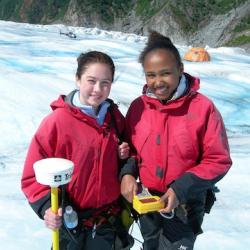Source Institutions
Source Institutions
Add to list Go to activity
Activity link broken? See if it's at the internet archive

This activity (located on page 3 of the PDF under GPS: Glaciers Activity) is a full inquiry investigation about the different causes of glacial melt. Groups of learners will design their own experiment using frozen "glaciers", bricks and different energy sources (fans, and lights) to test how different conditions affect the rate of melting. The results might be surprising. Relates to linked video, DragonflyTV GPS: Glaciers.
- 1 to 7 days
- 1 to 2 hours
- $5 - $10 per group of students
- Ages 8 - 14
- Activity, Experiment/Lab Activity, Lesson/Lesson Plan, Model
- English
Quick Guide
Materials List (per group of students)
- 3 lamps, each with a 75-watt bulb
- 3 fans
- 9 quart-sized plastic containers (like those from cottage cheese)
- 6 equal sized bricks (3 dark colored and 3 light colored)
- a beaker (1 liter capacity)
- a timer
- 9 plastic trays (at least 20 cm square and 5 cm deep)
- a graduated cylinder, 200 mL capacity
Subjects
-
Earth and Space Science
-
Earth Processes
- Weather and Climate
-
Earth Structure
- Oceans and Water
- Atmosphere
-
Earth's History
- Geologic Time
-
Earth Processes
-
Mathematics
-
Data Analysis and Probability
- Data Analysis
- Data Collection
- Data Representation
-
Measurement
- Units of Measurement
- Rate
- Representation
-
Data Analysis and Probability
-
Physical Sciences
-
Heat and Thermodynamics
- Heat and Temperature
- Heat Transfer
- Thermodynamics and Entropy
-
States of Matter
- Changes of Phase
-
Heat and Thermodynamics
-
The Nature of Science
-
The Scientific Process
- About Inquiry
- Asking Questions
- Conducting Investigations
- Gathering Data
- Formulating Explanations
- Communicating Results
-
The Scientific Process
Informal Categories
- Nature and Environment
Audience
To use this activity, learners need to:
- see
- see color
- read
- touch
Learning styles supported:
- Involves teamwork and communication skills
- Involves hands-on or lab activities
Other
Foreign language versions of this resource:
Components that are part of this resource:
This resource is part of:
Access Rights:
- Free access
By:
Source Collection
- DragonflyTV
Rights:
- All rights reserved, Twin Cities Public Television, Inc., 2007
Funding Source:
- National Science Foundation, 610429
